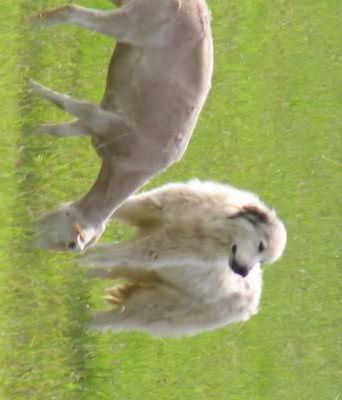brookcove
Posted : 7/19/2006 8:59:43 PM
If this dog was raised as a livestock guardian dog, she is more than shy - she is completely at sea without her flock/herd! I would not worry so much about her attitude toward strangers - it's not incumbant on every dog in the world to be lovey dovey with every person in the world. If someone wants to snuggle, just quietly explain, "She's a Katrina dog and she's still a little shook up." That should be enough to defuse any suspicion or fear on the part of strangers.
I've trained and bred Maremma sheepdogs for eight years and my heart just breaks at the thought of what this poor girl probably has been through. She certainly would have given her life for the safety of her flock and family, but somehow they were seperated and now everything is so different!
What she craves right now is routine and leadership. Yes, be positive, but be firm too. She's young, so it's possible to turn her guardian instincts to you and your home exclusively, but it will take some very clear direction.
Don't encourage antisocial behavior and definitely correct (yes, correct) any inappropriate guarding such as actively barking or posturing at strangers you have OKd. You will have to establish a protocol whereby you indicate that the alarm is over or the situation is acceptable to you.
In livestock guardian hierarchy, the lower ranking dogs sound the alarm, then look to the highest ranking member for a "plan of action." The signal to "go to battle stations" will be indicated by the alpha (bitch usually) warning the flock and taking her stand there while the rest go to meet the possible danger. Silence on her part means her greater experience or better perspective indicates a false alarm.
I highly recommend Patricia McConnell's book
The Other End of the Leash. In it she discusses how to communicate using signals similiar to what dogs learn to expect from other dogs. You can use her techniques to set the rules at your house and teach her what you expect, so you can work as a team to do what
she expects to do - guard you and yours.
If your new dog was a guardian dog, she is even more attuned to body language, and it is likely that at the moment she is being flooded with rudenesses and crossed signals beyond compare. It would be like landing on a planet where the middle finger salute was a pleasant greeting, four letter words were used for religious purposes, smiling was a fighting gesture, and total strangers said goodbye with a no-holds-barred French kiss. Even if she was simply a family pet, these dogs are not designed to switch context well, and all the above still applies.
Good luck! Here's one of my "babies"
